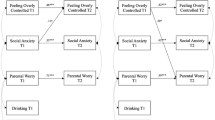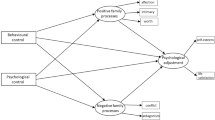Abstract
This study examined mediational and moderational effects of perceived control on the relationship between perceived parental rearing behaviors and symptoms of anxiety and depression in a nonclinical sample of youths aged 11–14 years. Correlational analyses demonstrated that higher levels of negative parental rearing practices were associated with higher levels of anxiety and depression, which at the same time were related to lower levels of perceived control. Furthermore, no evidence was found for the presence of mediational effects of perceived control on the link between perceived parental rearing behaviors and symptoms of anxiety and depression. Finally, there was a moderational effect of perceived control on the link between anxious rearing and anxiety symptoms. While the presence of low perceived control and high anxious rearing yielded relatively high anxiety levels, it was especially the combination of high perceived control and low anxious rearing that clearly yielded the lowest anxiety levels.
Similar content being viewed by others
REFERENCES
Alloy, L. B., Kelly, K. A., Mineka, S., and Clements, C. M. (1990). Comorbidity of anxiety and depressive disorders: A helplessness-hopelessness perspective. In Maser, J. D., and Cloninger, C. R. (eds.), Comorbidity of Mood and Anxiety Disorders. American Psychiatric Press, Washington, DC, pp. 499–543.
American Psychiatric Association (1994). Diagnostic and Statistical Manual of Mental Disorders, (4th ed.), American Psychiatric Association, Washington, DC.
Bandura, A., Pastorelli, C., Barbaranelli, C., and Caprara, G. V. (1999). Self-efficacy pathways to childhood depression. J. Pers. Soc. Psychol. 76: 258–269.
Baron, R. M., and Kenny, D. A. (1986). The moderator-mediator variable distinction in social psychological research: Conceptual, strategic, and statistical considerations. J. Pers. Soc. Psychol. Vol. 51: 1173–1182.
Barrett, P.M. (2001). Current issues in the treatment of childhood anxiety. In Vasey, M. W., and Dadds, M. R., (eds.), The Developmental Psychopathology of Anxiety. Oxford University Press, New York, pp. 304–324.
Bernstein, G. A., Borchardt, C. M., and Perwien, A.R. (1996). Anxiety disorders in children and adolescents: A review of the past 10 years. J. Am. Acad. Child Adolesc. Psychiatry, 35: 1110–1119.
Birmaher, B., Ryan, N. D., Williamson, D. E., Brent, D. A., Kaufman, J., Dahl, R. E., Perel, J., and Nelson, B. (1996). Childhood and adolescent depression: A review of the past 10 years. Part I. J. Am. Acad. Child Adolesc. Psychiatry, 35: 1427–1439.
Castro, J., Toro, J., Van der Ende, J., and Arrindell, W. A. (1993). Exploring the feasibility of assessing perceived parental rearing styles in Spanish children with the EMBU. Int. J. Soc. Psychiatry. 39: 47–57.
Chorpita, B. F. (2001). Control and the development of negative emotion. In Vasey, M. W., and Dadds, M. R., (eds.), The Developmental Psychopathology of Anxiety, Oxford University Press, New York. pp. 112–142.
Chorpita, B. F., and Barlow, D. H. (1998). The development of anxiety: The role of control in the early environment. Psychol. Bull. 124: 3–21.
Chorpita, B. F., Brown, T. A., and Barlow, D. H. (1998). Perceived control as a mediator of family environment in etiological models of childhood anxiety. Behav. Ther. 29: pp. 457–476.
Chorpita, B. F., Yim, L., Moffitt, C., Umemoto, L. A., and Francis, S. E. (2000). Assessment of symptoms of DSM-IV anxiety and depression in children: A revised child anxiety and depression scale. Behav. Res. Ther. 38: 835–855.
Cole, D., Jacquez, F., and Maschman, T. (2001). Social origins of depressive cognitions: A longitudinal study of self-perceived competence in children. Cogn. Ther. Res. 25: 377–395.
Grüner, K., Muris, P., and Merckelbach, H. (1999). The relationship between anxious rearing behaviours and anxiety disorders symptomatology in normal children. J. Behav. Ther. Exp. Psychiatry. 30: 27–35.
Halpin, B. M., and Ottinger, D. R. (1983). Children's locus-of-control scales: A reappraisal of reliability characteristics. Child Dev. 54: 484–487.
Muris, P. (2002). Relationships between self-efficacy and symptoms of anxiety disorders and depression in a normal adolescent sample. Pers. Individ. Differ. 32: 337–348.
Muris, P., Meesters, C., and Schouten, E. (2002). A brief questionnaire of DSM-IV defined anxiety and depression symptoms among children. Clin. Psychol. Psychother. 9: 430–442.
Muris, P., and Merckelbach, H. (1998). Perceived parental rearing behaviour and anxiety disorders symptoms in normal children. Pers. Individ. Differ. 25: 1199–1206.
Muris, P., Schouten, E., Meesters, C., and Gijsbers, H. (2003). Contingency-competence-control-related beliefs and symptoms of anxiety and depression in a young adolescent sample. Child Psychiatry Hum. Dev. 33: 325–339.
Nowicki, S., and Strickland, B. R. (1973). A locus of control scale for children. J. Consult. Clin. Psychol. 40: pp. 148–154.
Rapee, R. M. (1997). Potential role of childrearing practices in the development of anxiety and depression. Clin. Psychol. Rev. 17: 47–67.
Schneewind, K. A. (1995). Impact of family processes on control beliefs. In Bandura, A., (ed.), Self-efficacy in Changing Societies. Cambridge University Press, New York, pp. 114–148.
Vasey, M. W., and Dadds, M. R. (2001). An introduction to the developmental psychopathology of anxiety. In Vasey, M. W., and Dadds, M. R., (eds.), The Developmental Psychopathology of Anxiety. Oxford University Press, New York, pp. 3–26.
Weisz, J. R., Southam-Gerow, M. A., and McCarty, C. A. (2001). Control-related beliefs and depressive symptoms in clinic-referred children and adolescents: Developmental differences and model specificity. J. Abnorm. Psychol. 110: 97–109.
Weisz, J. R., Southam-Gerow, M. A., and Sweeney, L. (1998). The Perceived Control Scale for Children. University of California, Los Angeles, Los Angeles.
Author information
Authors and Affiliations
Rights and permissions
About this article
Cite this article
Muris, P., Meesters, C., Schouten, E. et al. Effects of Perceived Control on the Relationship Between Perceived Parental Rearing Behaviors and Symptoms of Anxiety and Depression in Nonclinical Preadolescents. Journal of Youth and Adolescence 33, 51–58 (2004). https://doi.org/10.1023/A:1027334314021
Issue Date:
DOI: https://doi.org/10.1023/A:1027334314021




